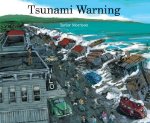Through the Looking Glass Children's Book Reviews
Tsunami Warning
Nonfiction Picture Book
For ages 8 to 10
Houghton Mifflin Books for Children, 2007 ISBN: 978-0618734634
When tsunamis hit coastlines in Asia and Africa on December 26, 2004, there was very little warning, and as a result 230,000 people died. Because of this terrible tragedy, governments from countries around the world decided that some kind of international tsunami emergency system needed to be put into place. This system is based on one built by NOAA (the U.S National Oceanic and Atmospheric Administration) many years ago, and there is no doubt that it will save countless lives in the years to come.
On April 1, 1946, an undersea earthquake near the Aleutian Islands sent huge waves racing across the ocean towards the Hawaiian Islands. When they hit the islands, they caused millions of dollars worth of damage and killed 159 people. The Hawaiians were furious that they had had no warning of the coming waves. After all, there was a NOAA seismograph on the island of Hawaii. Why didn’t it record the earthquake? The truth of the matter was that the seismograph recorded the earthquake on photographic paper that could only be read after it had been developed. This developing process took a whole day, which was much too long.
As a result of all the criticism, NOAA, the Pentagon, and scientists worked together to develop a more useful system. The system was tested on March 9, 1957, when a strong earthquake was detected by the seismograph in the NOAA station in Honolulu. This time alarm bells went off at once. Scientists then had to figure out if the earthquake took place under the ocean. If it had, it could cause tsunami waves. Because the alarms went off, a tide observer went to see if the equipment in the tide station was registering any unusual change in the water level. There were definite indications that a tsunami was on its way. People were evacuated to higher ground and a disaster was averted.
Since 1957 more advanced equipment has been developed as we have come to better understand what causes tsunamis and how they work. Today there are devices that have been placed on the ocean floor far out in the open ocean. Messages from an underwater bottom pressure recorder are sent to a buoy floating on the surface, which then sends a message to warning centers via a satellite.
This book tells the fascinating story of how life saving tsunami warning systems came to be developed, and how those systems have been expanded upon to make them more accurate. Building on the work done by scientists in the past, present day scientists are hopeful that they will be able to detect tsunamis more effectively so that the tragedy that took place on December 26, 2004 is not repeated. We cannot prevent tsunamis from happening, but we can make sure that we are watching for them, and that we are able to warm people that they are coming.




